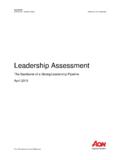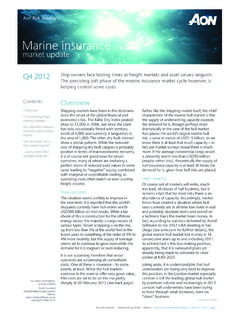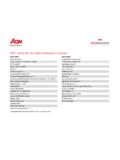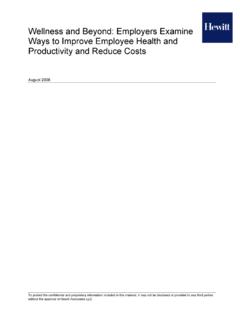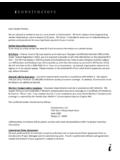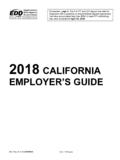Transcription of P I T 409A F D C JDand Lee Nunn - aon.com
1 JOURNAL OFDEFERREDCOMPENSATIONN onqualified Plans andExecutive CompensationEditor: Bruce J. McNeil, Esq. VOLUME 23, NUMBER 3 SPRING 2018 EDITOR S NOTEB ruce J. McNeil ADMINISTRATION MAKES THE PLANB ruce J. McNeil PREMIUM INTEREST TAX FOR 409A FAILURESR onald Gerard, Richard Hardeman, and Lee Nunn RISK OF A NONQUALIFIED PLANB ruce J. McNeil NONQUALIFIED DEFERRED COMPENSATION REPORTING AND WITHHOLDINGR onald Gerard, Elizabeth Groenewegen, and Lee NunnJDCW olters KluwerJournal of Deferred CompensationDistribution Center7201 McKinney CircleFrederick, MD 21704 Return Postage GuaranteedJOURNAL OF DEFERRED COMPENSATION VOLUME 23 NUMBER 3 SPRING 201810041436-005064 Nonqualified Deferred Compensation Reporting and WithholdingRONALD GERARD, ELIZABETH GROENEWEGEN, AND LEE NUNNR onald Gerard is a partner, Elizabeth Groenewegen is an associate partner, and Lee Nunn is a senior vice president at Aon Hewitt. They may be reached at and federal tax purposes, payments under nonqualified deferred compensation arrangements are considered supplemental wages for payroll tax Such wages are frequently paid well after they are earned, often in the form of retirement income, and ordinarily only to executives.
2 The nonqualified nature of the deferred compensation distin-guishes it from tax qualified arrangements, such as traditional pension plans and Internal Revenue Code (IRC) Section 401(k) plans. Examples of nonqualified deferred compensation (NQDC) include elective deferral arrangements, nonelective account balance arrangements, supplemental executive retirement plans (SERPs), and certain split-dollar insurance arrangements. Employers, participants, and even tax professionals may be confused about the reporting and withholding requirements because participants are often no longer active employees when the NQDC benefits are paid. This article discusses the reporting and withholding requirements for NQDC plans, generally. Excluded are deferred com-pensation arrangements under Internal Revenue Code Section 457 and issues arising under any state, local or law. Reporting require-ments include understanding which form to use and how to complete the form .
3 Withholding requirements include the amount and timing of with-holding for FICA taxes, federal income taxes, and state income REQUIREMENTS IN GENERALR eports for nonqualified deferred compensation generally are required to be made using form W-2, even when the recipient is no longer NONQUALIFIED DEFERRED COMPENSATION REPORTING AND WITHHOLDING / 65working for the enterprise that is reporting the An important exception is when the recipient is a beneficiary ( , the surviving spouse) or an alternate payee ( , a former spouse under a domestic relations order). Reports for these recipients are made using form Another important exception is compensation earned by independent contractors, such as members of a board of directors. Independent contractors also receive form 1099-MISC, but the reports are to be prepared in a slightly different manner as discussed later. Although NQDC may seem similar to a qualified retirement plan in certain respects, distributions from qualified retirement plans are reported on form REQUIREMENTS IN GENERALR equired tax withholding includes FICA tax, federal income tax, and certain state and local taxes to the extent applicable.
4 Although employer contributions to tax qualified plans are exempt from FICA taxes,5 NQDC is subject to FICA taxation,6 and usually before the ben-efits are subject to income taxes as discussed later. FICA withholding on wages is obligatory,7 and local payroll taxes may also be applicable. Unemployment taxes also apply to wages,8 but such taxes are entirely employer-paid in most states. Income tax withholding is required even when the wages are not paid in the form of This requires a separate withholding source to be arranged in advance of the required withhold-ing. Finally, states that levy income taxes on wages require withholding, including former states of residence in some TaxationWe start with FICA taxation because that s usually the tax to be withheld earliest. Compensation that meets the criteria for a NQDC plan ordinarily is taxed under FICA s special timing rule,10 which has separate rules for account balance plans11 and nonaccount balance The special timing rule usually minimizes FICA taxes because of the three-tier nature of the tax.
5 The three tiers are:1. Social Security tax on FICA wages up to the Social Security Wage Base ($128,400 for 2018) paid by both the employee and the employer ( in total);132. Medicare tax on all FICA wages, paid by both the employee and employer ( in total);143. Additional Medicare tax withholding on FICA wages in excess of $200,000 in a calendar year, paid by the / JOURNAL OF DEFERRED COMPENSATIONThe $200,000 threshold for the Additional Medicare Tax is a withholding The actual Additional Medicare Tax due may differ from the amount withheld, especially for taxpayers who are married and file jointly. The exact Additional Medicare Tax is calculated on form 8959 submitted with the employee s form 1040, and depends upon filing status and the spouse s FICA wages if a joint return is being filed. The following example compares the amounts of FICA taxes paid between years one year in which the executive has other wages that exceed the Social Security Wage Base and the other in which the execu-tive does not have other 1 Ann recognizes $100,000 of FICA wages from a non-qualified plan in a year when her other FICA wages are $300,000.
6 Her marginal FICA taxes are $2,350, which consists of $1,450 in Medicare tax and $900 in Additional Medicare tax. If Ann recognizes this $100,000 of FICA wages in retirement, when she has no other FICA wages, her FICA taxes will be $7,650, which consists of $6,200 in Social Security tax and $1,450 in basic Medicare tax. Paying FICA taxes under the special timing rule and when other FICA wages exceed the Social Security Wage Base saves Ann $5,300. Her employer saves $6,200 because her employer doesn t pay any Social Security tax. That s $11,500 in FICA savings between Ann and her employer, or of the FICA wages EmployersEach employer withholds FICA as if the employee has no FICA wages from other When an employee with high wages works for two or more employers in the same tax year, the employers will duplicate the Social Security Wage Base (on which Social Security taxes are levied)
7 , but the combined Additional Medicare Tax withheld may be less than the actual 2 Bob and Barbara are both single and both earn $500,000 in FICA wages, but Bob earns the wages from a single employer, whereas Barbara earns the wages equally from two employers during the same tax DEFERRED COMPENSATION REPORTING AND WITHHOLDING / 67 BobFICA ComponentAmountRateDollarsMedicare wages1$500, $7,250 Additional Medicare wages2$300, $2,700 Social Security wages3$128, $7,960 Total$17,910 BarbaraBarbaraFICA ComponentAmountRateSingle EmployerBoth EmployersCompared to BobMedicare wages1$250, $3,625 $7,250 Additional Medicare wages2 $50, $450 $900($1,800)Social Security wages3$128, $7,960$15,920 $7,960 Total$12,035$24,070 $6,1601 All FICA wages are subject to the Medicare Tax2 FICA wages in excess of $200,0003 Lesser of FICA wages or the Social Security Wage Base ($128,400 for 2018)Bob and Barbara incur the same amount of FICA tax.
8 Bob s with-holding equals the taxes he incurs because the withholding rules and the tax rates align for single employees who work for only one employer. Although Barbara owes only $7,960 in Social Security taxes, she has had $15,920 withheld. She will recover the excess Social Security taxes as a credit when she files her income tax Conversely, although Barbara owes $2,700 in Additional Medicare tax, she has had a com-bined total of only $900 withheld. She will owe the remainder and include form 8959 with her personal tax ContractorsIndependent contractors, such as nonemployee members of the board of directors, pay Self Employment Contributions Act (SECA) tax instead of FICA tax, which essentially combines the employee and employer components of the FICA The SECA tax is not eligible for the special timing rule. Instead, independent contractors pay SECA tax under the general timing rule on distribu-tions.
9 Because the general timing rule often increases taxes paid (as explained above), elective deferrals may not make economic sense for independent contractors. Absent failures under IRC Section 409A, SECA income from nonqualified plans earned by independent con-tractors is limited to distributions reported on form 1099-MISC,20 as discussed / JOURNAL OF DEFERRED COMPENSATIONT iming of FICA TaxThe timing of the FICA taxes under the special timing rule depends on whether the arrangement is account balance or nonaccount balance. Account balance arrangements pay benefits based solely on a principal amount and income (or loss) on that principal All other nonqualified deferred compensation arrangements are nonac-count Account balance plan benefits are included in FICA income when the benefits are no longer subject to a substantial risk of forfeiture, meaning that the amount is For example, elec-tive deferrals are included in FICA wages at the time of deferral.
10 An employer match with delayed vesting taxes the match, accumulated with interest (or loss), at the time of vesting. Under the special timing rule, the present value of a nonaccount balance plan can be included in FICA income when the value of the benefits is reasonably ascertainable ( , the resolution date),24 which is often separation from service or the benefit commencement date. Once FICA taxes are paid, no additional FICA taxes are due on any growth in the value of the benefits under FICA s nonduplication When death creates a vesting event or a resolution date, the value of all benefits paid in the year of death are included in FICA wages to the extent not previously included in FICA wages under the special timing rule. All amounts are treated as FICA wages, including amounts paid to precise timing of FICA taxation is triggered by the vesting date (for account balance plans) or the resolution date (for nonac-count balance plans).

